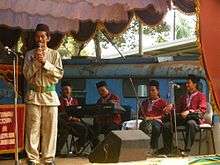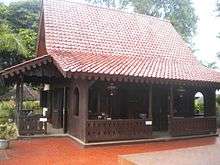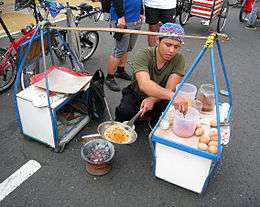Betawi people
|
Betawi wedding costume demonstrate both Middle Eastern (groom) and Chinese (bride) influences. | |
| Total population | |
|---|---|
| (5 million (2000 census)) | |
| Regions with significant populations | |
| Jakarta: 2.3 million | |
| Languages | |
| Betawi, Indonesian | |
| Religion | |
| Sunni Islam (predominantly), Christianity | |
| Related ethnic groups | |
| Sundanese, Javanese, Balinese, Malay, Tionghoa, Ambonese, Cocos Malays |
Betawi people (Orang Betawi in Indonesian meaning "people of Batavia") often described as the native Jakartans.[1] They are the descendants of the people living in and around Batavia (the colonial name of Jakarta) from around the 17th century.[2][3] Although the term "native" itself is questionable, since Betawi people was formed in the 18th century as an amalgamation of various immigrant ethnic groups into Batavia.[4]
Etymology
The name "Betawi" is derived from Batavia, the old colonial name of Jakarta.[3] In neighboring Javanese and Sundanese languages, the term "Betawi" did originally do refer to colonial Batavia. Thus the term orang Betawi refer to "people of Batavia" or "Batavians", which originally consists of diverse ethnic groups and various demographic make up of the coastal Dutch colony; either within the 17th century fortified city of Old Batavia (now Kota area) or surrounding villages.
Origin and history
The Betawis are one of the youngest, or the latest formed ethnic group in Indonesia. They are a creole ethnic group that their ancestors came from various parts of Indonesia and abroad. Prior to the 19th century, the self-identity of Betawi people was not yet formed.[4]
In the 17th century, Dutch colonials began to imported servants and labours from all over the archipelago into Batavia. One of the earliest are Balinese slaves brought from Bali and Ambonese mercenaries. Subsequently other ethnic groups follow suit; they are Malays, Sundanese, Javanese, Minangkabau, Bugis and Makassarese. Foreign ethnic groups were also included; such as Mardijker, Portuguese, Dutch, Arabs, Chinese and Indian, who was originally brought to or attracted to Batavia to meet labour needs.[4]

Originally, circa 17th to 18th century, the dwellers of Batavia were identified according to their ethnics of origin; either Sundanese, Javanese, Malay, Ambonese, Bugis-Makassar, to Arabs and Chinese. This was shown in the Batavia census record that listed immigrant's ethnic background of Batavia's citizen. They were separated in different enclave of specific ethnic-based kampungs, that is why in today's Jakarta there are some region named after an ethnic-specific names such as; Kampung Melayu, Kampung Bali, Makassar and Kampung Ambon. These ethnic groups merged and formed in around 18th to 19th century. It was not until late 19th or early 20th century that those group — who would become the dwellers of Batavia, would refer themselves as "Betawi", which refer to a creole Malay-speaking ethnic group which has a mixed culture of different influences; Malay, Sundanese to Arabic and Chinese.[3] The term "Betawi" was first listed as an ethnic category in 1930 census of Batavia residents.[4]
The Betawi people have a culture and language distinct from the surrounding Sundanese and Javanese. The Betawis are known for their traditions in music and food.[5]
Language
The Betawi language—also known as Betawi Malay, is a Malay-based creole language. It was the only Malay-based dialect spoken in northern coast of Java; other northern Java coastal areas are overwhelmingly dominated by Javanese dialects, while some parts are speaking Madurase and Sundanese. Betawi vocabulary has large amount of Hokkien Chinese, Arabic, and Dutch loanwords. Today the Betawi language is a popular informal language in Indonesia and used as the base of Indonesian accent. It has become one of widely-spoken language in Indonesia, and also one of active local dialect in the country.[6]
Religion
Majority of the Betawi people follow Sunni Islam. However, there are significant number of them who profess the Christian faith. Among the Betawi ethnic Christians, some have claimed that they are the descendants of the Portuguese Mardijker which intermarried with the local population, whom mainly settled in the area of Kampung Tugu, North Jakarta. Although today Betawi culture is often perceived as a Muslim culture, it also had other roots which includes Christian Portuguese and Chinese Peranakan culture. Recently, there is an ongoing debate on defining Betawi culture and identity—as mainstream Betawi organization are criticized for only accommodating Muslim Betawi while marginalizing non-Muslim elements within Betawi culture—such as Portuguese Christian Betawi Tugu and Tangerang Cina Benteng community.[7]
Culture
The culture and artform of the Betawi people demonstrate the influences experienced by them throughout their history. Foreign influences are visible, such as Portuguese and Chinese influences on their musics, and Sundanese, Javanese and Chinese influences in their dances. Contrary to popular perception, which believed that Betawi culture is currently marginalized and under pressure from the more dominant neighbouring Javanese and Sundanese culture—Betawi culture is actually thriving, since it is being adopted by immigrants who has settled in Jakarta. The Betawi culture also has become an identity for the city, promoted through municipal government patronage. The Betawi dialect is often spoken in TV shows and drama.[8]
Music

The Gambang kromong and Tanjidor, as well as Keroncong Kemayoran music is derived from the kroncong music of Portuguese Mardijker people of Tugu area, North Jakarta.
Dance and drama

The Ondel-ondel large bamboo masked-puppet giant effigy is similar to Chinese-Balinese Barong Landung and Sundanese Badawang, the artforms of masked dance.[9] The traditional Betawi dances costumes shows both Chinese and European influences, while the movements such as Yapong dance,[10] which is derived from Sundanese Jaipongan dance with a hint of Chinese style. Another dance is Topeng Betawi or Betawi mask dance.[11]
Betawi popular folk drama is called lenong, which is a form of theater that draw themes from local urban legends, foreign stories to everyday life of Betawi people.[12]
Martial arts

Silat Betawi is a martial art of Betawi people, which was not quite popular, but recently has gained wider attention thanks to the popularity of silat films, such as The Raid.[13] Betawi martial art was rooted in Betawi culture of jagoan (lit. "tough guy" or "local hero") that during colonial times often went against colonial authority; despised by the Dutch as thugs and bandits, but highly respected by local pribumis as native's champion. In Betawi dialect, their style of pencak silat is called maen pukulan (lit. playing strike) which related to Sundanese maen po. Notable schools among other are Beksi and Cingkrik. Beksi is one of the most commonly practiced forms of silat in Greater Jakarta, and is distinguishable from other Betawi silat styles by its close-distance combat style and lack of offensive leg action.[14]
Ceremonies
During a Betawi wedding ceremony, there is a palang pintu (lit. door's bar) tradition of silat Betawi demonstration. It was a choreographed mock fighting between groom's entourage with bride's jagoan kampung (local champion). The fight is naturally won by groom's entourage as the village champs welcomes him to bride's home.[13] The traditional wedding dress of Betawi displays Chinese influence in bride's costume and Arabian influences in groom's costume.[3] Betawi people borrowed Chinese culture of firecrackers during wedding, circumcisions or any celebrative events. The tradition of bringing roti buaya (crocodile bread) during wedding is probably a European custom.
Other Betawi celebrations and ceremonies include sunatan or khitanan (Muslim circumcision), and Lebaran Betawi festival.[15]
Cuisine
As a thriving port city, the cuisine of Betawi is eclectic as it reflects the foreign culinary traditions that has been influenced the inhabitant of Jakarta for centuries. Betawi cuisine is heavily influenced by Peranakan Cuisine of Chinese Indonesian, Malay cuisine, neighboring Sundanese and Javanese cuisine, to some extent Indian, Arabic and European cuisines.[16] Betawi people have several popular cuisines, such as soto betawi, soto kaki, nasi uduk, kerak telor, nasi ulam, asinan, ketoprak, rujak, semur jengkol, sayur asem, gabus pucung, and gado-gado Betawi.
Architecture

Traditionally Betawi people are not an urban dweller living in gedong (European-style building) or two-storied Chinese rumah toko (shophouse) clustered in and around Batavia city walls. They are living in kampungs around the city filled with orchards. As Jakarta become more and more densely populated, so does Betawi traditional villages that mostly now turned into a densely packed urban village with humble houses tucked in between high rise buildings and main roads. Some of more authentic Betawi village survived only in the outskirt of the city, such as in Setu Babakan, Jagakarta, South Jakarta bordering with Depok area, West Java. Traditional Betawi houses can be found in Betawi traditional kampung (villages) in Condet and Setu Babakan area, East and South Jakarta.[5]
Betawi houses are typically one of three styles: rumah bapang (or rumah kebaya), rumah gudang (warehouse style), and Javanese-influenced rumah joglo. Most betawi houses have a gabled roof, with the exception the joglo house, which has a high pointed roof. Betawi architecture has a specific ornamentation called gigi balang ("grasshopper teeth") which are a row of wooden shingles applied on the roof fascia. Another distinctive characteristics of Betawi house is a langkan, a framed open front terrace where Betawi family receive their guests. The large front terrace is used as an outdoor living space.[5]
Notable people

- Benyamin Sueb (1939-1995), Indonesian legendary comedian, singer and actor
- Mandra, Indonesian famous comedian
- Ayu Tingting (1992-), dangdut singer
- Fauzi Bowo (1948-), governor of Jakarta 2007-2012
- Nawi Ismail (1918-1990), film maker and actor
- Ismail Marzuki (1914-1958), Indonesian composer and musician
- Mohammad Husni Thamrin (1894-1941), National Hero of Indonesia
- Iko Uwais (1983-), martial art actor
References
- ↑ Knorr, Jacqueline (2014). Creole Identity in Postcolonial Indonesia. Volume 9 of Integration and Conflict Studies. Berghahn Books. p. 91. ISBN 9781782382690.
- ↑ No Money, No Honey: A study of street traders and prostitutes in Jakarta by Alison Murray. Oxford University Press, 1992. Glossary page xi
- 1 2 3 4 Dina Indrasafitri (26 April 2012). "Betawi: Between tradition and modernity". The Jakarta Post. Jakarta.
- 1 2 3 4 "Debunking the 'native Jakartan myth'". The Jakarta Post. Jakarta. 7 November 2011.
- 1 2 3 Indah Setiawati (24 June 2012). "Betawi house hunt". The Jakarta Post. Jakarta.
- ↑ Setiono Sugiharto (21 June 2008). "The perseverance of Betawi language in Jakarta". The Jakarta Post. Jakarta.
- ↑ "Betawi or not Betawi?". The Jakarta Post. Jakarta. 26 August 2010.
- ↑ "What to become of native Betawi culture?". The Jakarta Post. Jakarta. 26 November 2010.
- ↑ "Betawi style". The Jakarta Post. 1 September 2013.
- ↑ "Yapong Dance, Betawi Traditional Dance". Indonesia Tourism. 27 March 2013.
- ↑ "Jakarta Traditional Dance – Betawi Mask Dance". Indonesia Travel Guide. 4 August 2015.
- ↑ "Lenong". Encyclopedia of Jakarta (in Indonesian). Jakarta City Government. 13 October 2013. Archived from the original on 2013-10-13.
- 1 2 Indra Budiari (13 May 2016). "Betawi 'pencak silat' lays low among locals". The Jakarta Post. Jakarta.
- ↑ Nathalie Abigail Budiman (1 August 2015). "Betawi pencak silat adapts to modern times". The Jakarta Post. Jakarta. Retrieved 10 August 2015.
- ↑ Irawaty Wardany (23 August 2015). "Lebaran Betawi: An event to maintain bonds and traditions". The Jakarta Post. Jakarta.
- ↑ Indah Setiawati (8 November 2013). "Weekly 5: A crash course in Betawi cuisine". The Jakarta Post. Retrieved 5 August 2016.
Bibliography
- Castles, Lance The Ethnic Profile of Jakarta, Indonesia vol. I, Ithaca: Cornell University April 1967
- Guinness, Patrick The attitudes and values of Betawi Fringe Dwellers in Djakarta, Berita Antropologi 8 (September), 1972, pp. 78–159
- Knoerr, Jacqueline Im Spannungsfeld von Traditionalität und Modernität: Die Orang Betawi und Betawi-ness in Jakarta, Zeitschrift für Ethnologie 128 (2), 2002, pp. 203–221
- Knoerr, Jacqueline Kreolität und postkoloniale Gesellschaft. Integration und Differenzierung in Jakarta, Frankfurt & New York: Campus Verlag, 2007
- Saidi, Ridwan. Profil Orang Betawi: Asal Muasal, Kebudayaan, dan Adat Istiadatnya
- Shahab, Yasmine (ed.), Betawi dalam Perspektif Kontemporer: Perkembangan, Potensi, dan Tantangannya, Jakarta: LKB, 1997
- Wijaya, Hussein (ed.), Seni Budaya Betawi. Pralokarya Penggalian Dan Pengem¬bangannya, Jakarta: PT Dunia Pustaka Jaya, 1976

